Bananas are among the healthiest fruits on earth, so they are popular everywhere. Plants are mostly grown for food and cultivated for textile fiber and ornamental purposes. Most modern edible parthenocarpic Bananas come from two wild species; Musa acuminata and Musa balbisiana. It is not a tree but a high herb that can reach a height of up to 15 meters. It is important to note that cultivars differ greatly in terms of plant and fruit size, morphology, quality, and disease and insect resistance.
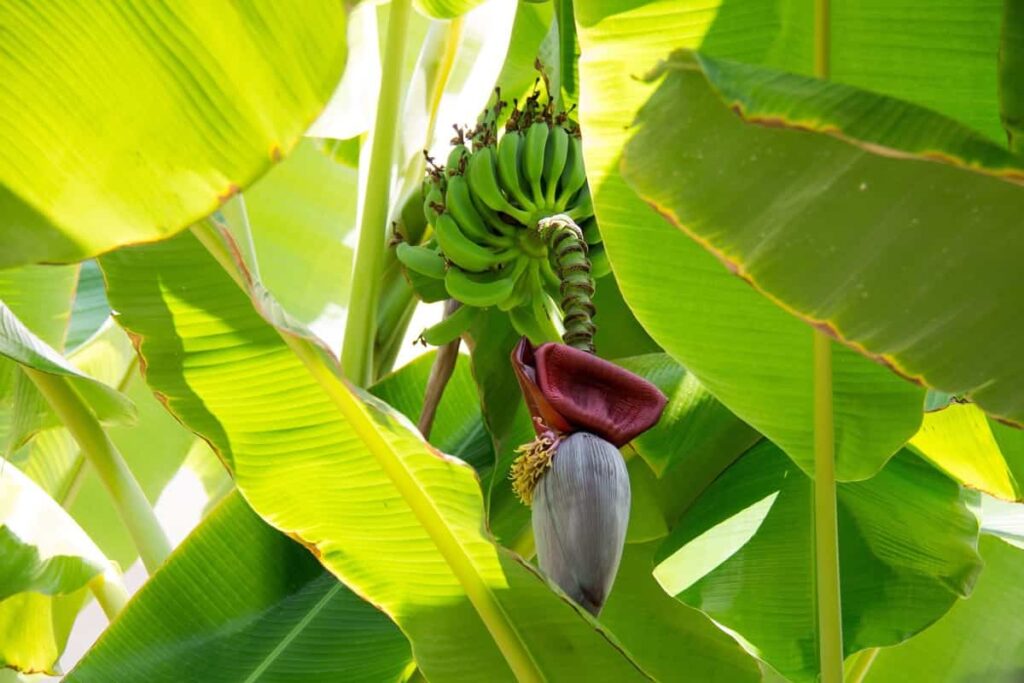
With 97.5 million tons of production, Bananas are the world’s most important fruit crop. After mango, it is the second most essential fruit crop in India. The Banana is one of the most famous fruits because it’s available all year long, affordable, nutritious, delicious, and medicinal. Millions of people in India depend on it for their livelihood.
With 25 tons per acre, Maharashtra ranks first in production, and in India, Bananas account for 37% of total fruit production. Among India’s total area under crop, Bananas occupy 20% of the area. In terms of area and productivity, Maharashtra ranks second in the country. Approximately 1,24,000 acres of land are under Banana cultivation in Jalgaon, a major Banana growing district in Maharashtra.
High yield hybrid Banana varieties in India
Around the world, there are more than 300 varieties of Bananas. However, the majority of Indian farmers use only 15 to 20 varieties.
Dwarf Cavendish
The cultivar is widely grown in Maharashtra, Gujarat, Bihar, and West Bengal for table and processing purposes. Tamil Nadu, Karnataka, and Andhra Pradesh are among the states where it is popular. As well as being the leading Cavendish variety, ‘Basrai’ is the leading commercial variety in Maharashtra.
Due to its dwarf stature, the plant is less susceptible to wind damage. Fruit length, size, and bunch size are quite good, but keeping quality is poor. Approximately 15 to 25 kg is the average bunch weight with 6-7 hands and about 13 fruits per hand. When the fruits are ripe, the thick rind retains a greenish color to some extent.
Robusta
This semi-tall variety is primarily grown for table use in Tamil Nadu, Karnataka, Andhra Pradesh, and Maharashtra. The fruit is large and well-developed and produces a high yield. The bright yellow colored fruits are very sweet and aromatic depending on the ripening conditions. Approximately 25 to 30 kilograms make up the bunch. Since the pulp quickly breaks down after ripening, the fruit is unsuitable for long-distance transportation due to its poor keeping quality. The Sigatoka leaf spot disease is highly prevalent in humid tropics and highly susceptible to Robusta.
Rasthali
Commercially grown in Tamil Nadu, Andhra Pradesh, Kerala, Karnataka, and Bihar, it is a medium-tall variety. Known for its unique fruit quality, Rasthali is a highly prized cultivar for table use. Fruits are yellowish green during development but turn pale to golden yellow when ripe. The fruit is very tasty and has a pleasant aroma. However, a longer crop duration, a high susceptibility to Fusarium wilt, the need for bunch covers to protect fruits from sun cracking, and the formation of hard lumps in fruits contribute to higher crop production costs.
Poovan
There are various location-specific ecotypes of this cultivar in the country, including Palayankodan in Kerala, Poovan in Tamil Nadu, Karpura Chakkarakeli in Andhra Pradesh, and Alpan in the North Eastern region. The crop is generally grown as a perennial. Due to the climatic conditions and marginal soil conditions, Tamil Nadu produces the most Poovan cultivars. Poovan is commercially cultivated for the leaf industry in Tamil Nadu and Kerala.
In case you missed it: High Yield Hybrid Grapes Varieties in India: State Wise Varieties Cultivated
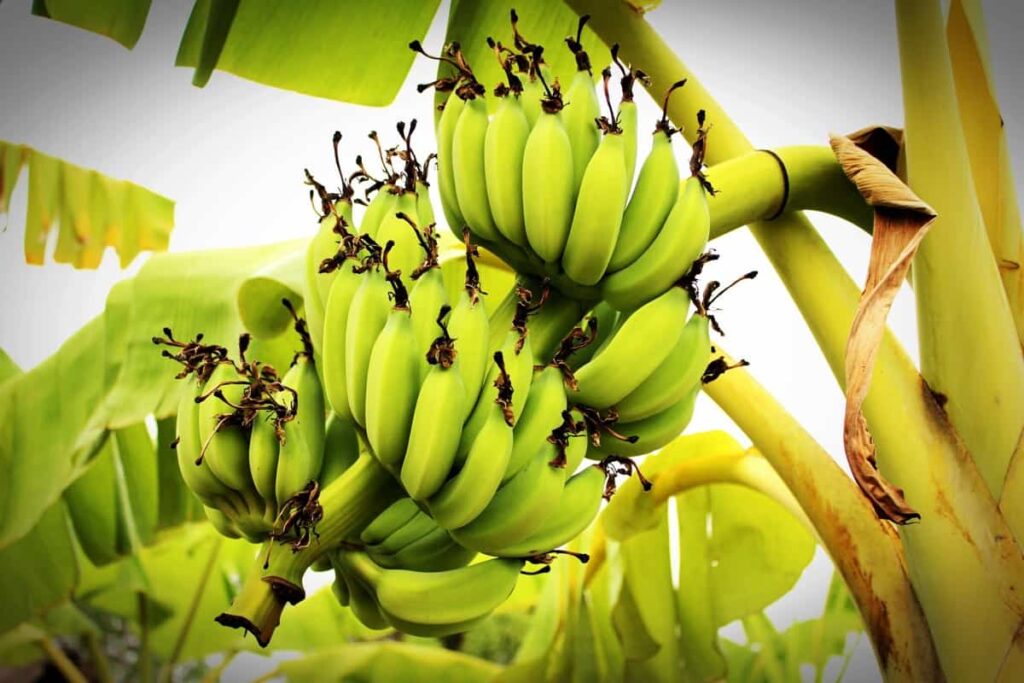
The fruit has a sour-sweet aroma and is slightly acidic. As the fruit ripens, it turns an attractive golden yellow. A medium-sized bunch, closely packed fruits, good keeping quality, and resistance to cracking are its plus points. However, it is highly susceptible to Banana Bract Mosaic Viral (BBMV) disease and Banana Streak Virus (BSV), significantly reducing the plant’s yield.
Gandevi
The Gandevi selection, also known as Hanuman or Padarre, is gaining popularity despite its longer crop duration. The selection produces bunches weighing 55 to 60 kg. It performs well in light soils with high inputs. In combination with high-density planting and drip irrigation, Dwarf Cavendish is a highly successful cultivar. It is, however, highly susceptible to Sigatoka leaf spot disease in humid tropics, which restricts its commercial cultivation.
Nendran
As fruit and for processing, it is a popular variety in Kerala. In recent years the commercial cultivation of Nendran has seen rapid growth in Tamil Nadu. Among Nendran varieties, there can be considerable variation in plant stature, pseudostem color, absence of male axis, bunch size, etc. The bunch weighs about 12 to 15 kg and has five to six hands. The fruit’s neck becomes buff yellow with thick green skin after ripening. The starchy texture of the fruits remains even after they have ripened. It is susceptible to Banana Bract Mosaic Virus (BBMV), nematodes, and borer infestations.
Red Banana
There is no doubt that the red Banana is the most cherished and highly prized variety of Bananas in Kerala and Tamil Nadu. Tamil Nadu’s Kanyakumari and Tirunelveli districts are the most prominent commercial cultivation areas. Besides Karnataka and Andhra Pradesh, it is also popular in West and Central India to a limited extent.
In case you missed it: High-yield Hybrid Papaya Varieties in India: How to Grow, Fertilizers, Pests, and Diseases
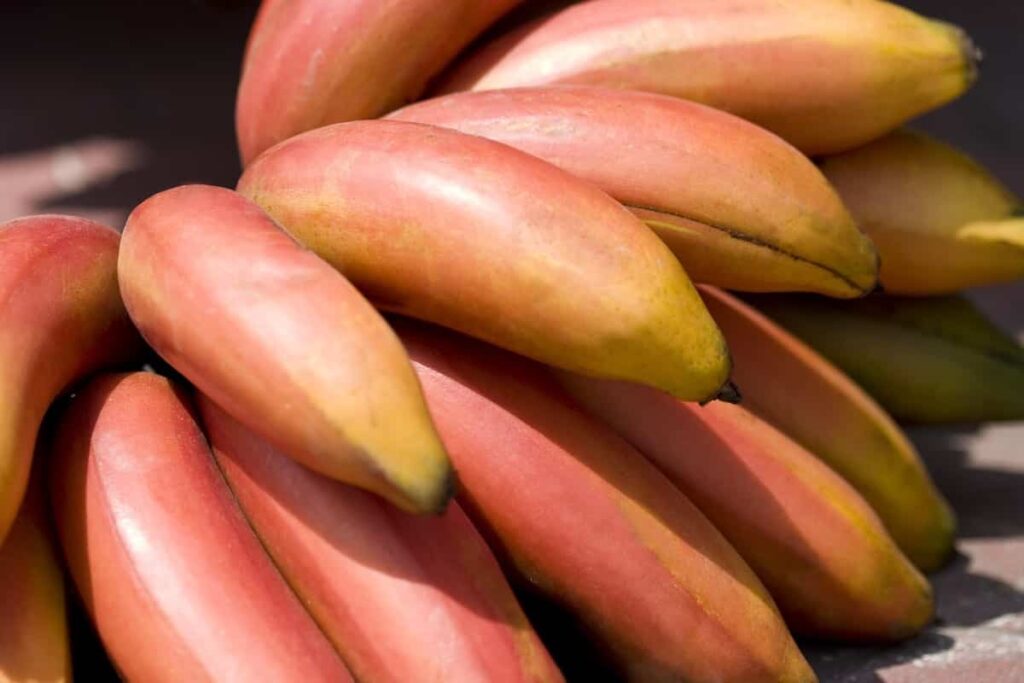
As far as Bihar is concerned, it is known as Lal Velchi, whereas in Karnataka, it is known as Chandra Bale. There is a purplish red hue to the pseudostem, petiole, midrib, and fruit rind. Using good management practices, it produces bunches weighing 20 to 30 kg. There is a pleasant aroma to the fruit, which is orange-yellow and sweet. The plant is highly susceptible to bunchy top, fusarium wilt, and nematodes
Ney Poovan
Especially in Tamil Nadu and Karnataka, Ney Poovan is the most preferred diploid cultivar under commercial monoculture. Large-scale cultivation is now taking place in Kerala, which was previously grown in backyards. Ney Poovan is a slender plant that bears 15 to 30 kg bunches after 12 to 14 months of growth. The dark green fruits will turn golden yellow and keep very well. The fruit is firm, powdery, and highly fragrant. Leaf spots are tolerant to Ney Poovan; however, Fusarium wilt and Banana bract mosaic virus are susceptible.
Virupakashi
In South India, it is grown under perennial cultivation in the Palani and Shevroy hills of Tamil Nadu for table purposes. Although not prolific, it is a vigorous and hardy variety. Fruits have a characteristic curvature, a pleasant aroma, and a delightful taste. Virupakshi has a distinguished flavor only when they are grown in higher elevations.
The plant is best suited as a shade plant for coffee plants in mixed cultivation. Many ecotypes of the crop are found in the plains, including the ‘Sirumalai’ (grown on hills), the ‘Vannan,’ and the ‘Kali.’ The perennial system of cultivation aggravates Banana Bunchy Top Virus (BBTV).
Pachanadan
In Tamil Nadu, it is a popular variety grown for its cooling effects during the summer. There is no yield reduction when the variety is grown in marginal soils. A coconut or arecanut garden would benefit from its use as an intercrop. The bunch weight ranges from 12 to 15 kg (after 11 to 12 months). It could fill gaps in Nendran plantations as Pachanadan comes up for harvest alongside Nendran. Banana Bunchy Top Virus (BBTV) and leaf spot are tolerant of this variety, but wilt is susceptible.
Monthan
This variety is widely cultivated for processing. The Monthan plant grows fairly tall and produces 18 to 20 kg bunches after 12 months. The fruits are bright green, stocky, knobbed, and bold. The skin is usually green. The new clones of the ‘Monthan’ type of economic value, namely ‘Kanchi Vazhai’ and ‘Chakkia,’ have recently become popular in Tamil Nadu. Besides being a highly relished vegetable with medicinal properties, pseudostem core can also be used in cooking.
In the Trichy and Tanjore districts of Tamil Nadu, Monthan is also grown for its leaves. It has many desirable qualities, including immunity to Banana bunchy top virus (BBTV) diseases, salt tolerance, and normal bunch mass, even under marginal conditions. However, Fusarium wilt is still a serious threat to it.
In case you missed it: High Yield Hybrid Mango Varieties in India: State Wise Growing Guide
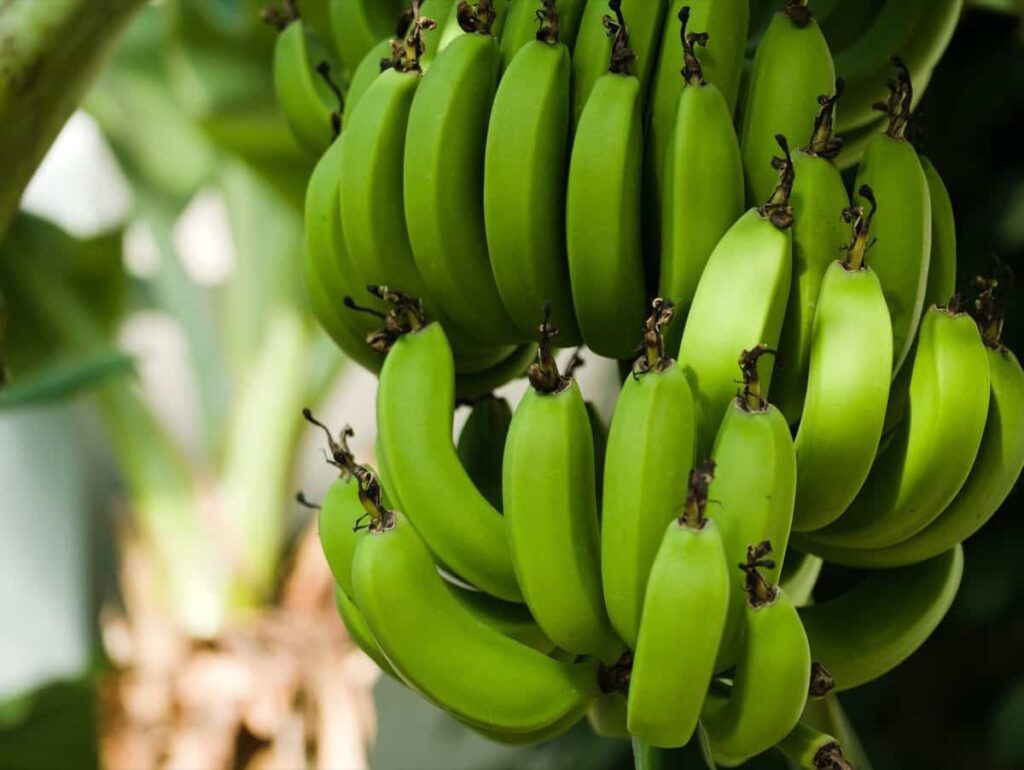
Karpuravalli
The variety is widely grown in medium-rich soils as a table vegetable. It is commercially grown in Tamil Nadu and Kerala’s Central and Southern districts. The plant is cultivated in patches named ‘Kanthali’ in Bihar. Karpuravalli is a tall, robust plant that does well on marginal lands and soils and requires low inputs for growth.
As well as being the sweetest of Indian Bananas, it is occasionally seeded, depending on seasonal changes. Its ash-coated golden yellow and sweet fruits have good keeping quality. Suitable for drought, salt-affected areas, and low input conditions, Karpuravalli is highly susceptible to wilt disease and tolerant of leaf spots.
Safed Velchi Musa
Maharashtra’s Thane and Nasik districts cultivate this good-quality table fruit. The South Kanara districts of Karnataka grow this variety under the shade of arecanut gardens, and it is medium-sized with a slender yellowish-green pseudostem. A reddish petiole margin, large fruits, extremely thin and papery rind, and very sweet white firm flesh distinguish it from other varieties. There are approximately 150 fruits per bunch, with an average bunch weight of 12 kg. The duration of the variety is about 13 months.
CO 1
Tamil Nadu Agricultural University, Coimbatore, released this hybrid clone involving three parents – Ladan, Kadali, and Musa balbisiana. In flavor and taste, it is similar to the hill Banana Virupakshi and can be grown up to 1200 meters in elevation in plains and hills. The yield per acre is approximately 9 tons. Fourteen months are required for the crop to mature.
H1
Clusters produced by this hybrid medium-height plant variety range from 14 to 16 kilograms. The fruits of this plant are long and turn yellow when they are ripe. The taste is mildly sour, even when they are cooked.
Udhayam
The National Research Centre for Banana, Trichi, developed this hybrid by selecting single plants from the Pisang Awak subgroup. Hardy, tall, and robust, the plant weighs between 30-35 kg. A cylindrical shape and well-spaced hands facilitate packing, loading, and transporting without causing damage to the product.
The fruit quality is medium, and the sugar acid blend is good, with a maximum yellow life of 7 days. Suitable for wind-prone areas, it is the ideal cultivar. Even under marginal conditions, Banana Bunchy Top is immune to viral diseases, is salt-tolerant, and has normal bunch mass. However, the plant is highly susceptible to Fusarium wilt.
FHIA-01
Also known as Gold finger, it is a high-yielding hybrid that replaces Pachananda and Bluggoe varieties. It is a Pome hybrid created in Honduras by crossing SH-3142 with Dwarf Prata. In 14 to 15 months, heavy bunches of fruit (20 to 25 kg) are produced without propping. There is a sub-acidic or apple flavor to the fruit.
However, burrowing nematodes and black Sigatoka wilt are highly resistant to it. Fruits have a long shelf life without premature detaching. The fruit is used for multiple purposes and has a superior yield, quality, and growth parameters than Pachanadan. Furthermore, its sodicity tolerance makes it ideal for India’s saline-sodic soils.
In case you missed it: High Yield Hybrid Paddy/Rice Varieties in India: For Rabi and Kharif Seasons
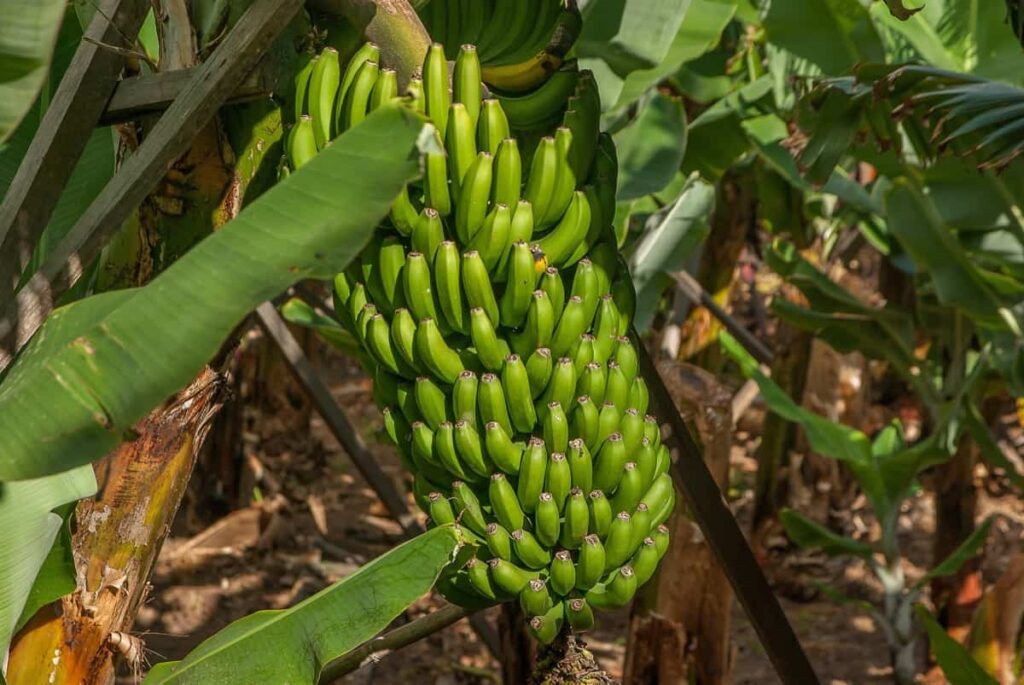
Grand Naine
Grand Naine comes from its relative height compared to other Cavendish cultivars. It is taller than the Dwarf Cavendish cultivar but shorter than the Giant Cavendish cultivar. Bananas of this variety are the most widely recognized international variety. On average, it produces a 25 kg bunch, but it can reach 32 to 35 kg with 8 to 10 hands and 200 to 220 fruits. Its length is 15 to 21 cm, and its circumference is 12 to 13 cm.
Banana varieties cultivation in different states of India
| State | Varieties cultivating |
| Karnataka | Robusta, Rasthali, Dwarf Cavendish, Poovan, Monthan, Elakkibale |
| Kerala | Nendran (Plantain), Rasthali, Palayankodan (Poovan), Monthan, Red Banana, Robusta |
| Andhra Pradesh | Dwarf Cavendish, Rasthali, Robusta, Amritpant, Thellachakrakeli, Chakrakeli, Monthan, Karpoora Poovan and Yenagu Bontha |
| Tamil Nadu | Robusta, Virupakshi, Red Banana, Poovan, Rasthali, Monthan, Karpuravalli, Nendran, Sakkai, Peyan, Matti |
| Assam | Jahaji, Chini Champa, Kanchkol, Malbhog, Honda, Manjahaji, Borjahaji (Robusta), Chinia (Manohar), Bhimkol, Digjowa, Kulpait, Jatikol and Bharat Moni |
| Jharkhand | Basrai, Singapuri |
| Bihar | Chinia, Dwarf Cavendish, Alpon, Chini Champa, Kothia, Malbhig, Muthia, Gauria |
| Gujarat | Lacatan, Dwarf Cavendish, Harichal (Lokhandi), Gandevi Selection, Basrai, Robusta |
| Madhya Pradesh | Basrai |
| Maharashtra | Dwarf Cavendish, Shreemanti, Basrai, Robusta, Lal Velchi, Safed Velchi, Grand Naine, Red Banana, Rajeli Nendran |
| Orissa | Dwarf Cavendish, Robusta, Champa |
| West Bengal | Mortman, Champa, Dwarf Cavendish, Giant Governor, Singapuri |
Banana season in India
Bananas originated in Southeast Asia’s humid tropical regions. There are currently 120 nations cultivating Bananas throughout the warm tropical areas of the world. In India, Banana season lasts throughout the year. The arrival of Bananas increases in April and peaks between August and October. Approximately 20% of India’s cropland is devoted to Bananas. Generally, Bananas thrive in temperatures of 15°C to 35°C and relative humidity levels of 75% to 85%.
After planting, the Banana crop is ready for harvest 12 to 15 months later, with September to April being the primary harvesting season. Tamil Nadu and other southern states like Karnataka and Andhra Pradesh have annual Banana seasons. In addition, it is possible to harvest Bananas throughout the year in northern and eastern Maharashtra, Manipur, Assam, and Tripura. Harvesting season starts in September and ends in November in states such as Gujarat, Bihar, Uttar Pradesh, and Jharkhand. Banana season prevails year-round in India, making it an unavoidable necessity for processing and retail.
Harvesting Bananas
The dwarf varieties are harvested after 12 to 15 months of planting. For tall varieties, harvesting takes place after 15 to 18 months. As fruits mature, they become plump, have filled angles, make a metallic sound when tapped, dry off the top leaves, and change color from dark green to light green. The tall variety yields between 6 and 10 tons per acre, while the dwarf variety yields between 10 and 20 tons per acre.
To sell fruits locally, harvest them when they are mature, and for long-distance transportation, harvest them when they are 75-80% mature. When harvesting for export, do it the day before or the same day as shipping. The best time to harvest fruit in the summer is early morning. However, avoid harvesting too early in the morning in winter. Fruits are commonly harvested early in the crop season at a premature stage to capture the market. Then mature fruits are ripened with Ethrel doses for uniform color development.
In case you missed it: High Yield Hybrid Cotton Varieties in India – For Rabi, and Kaharif Seasons
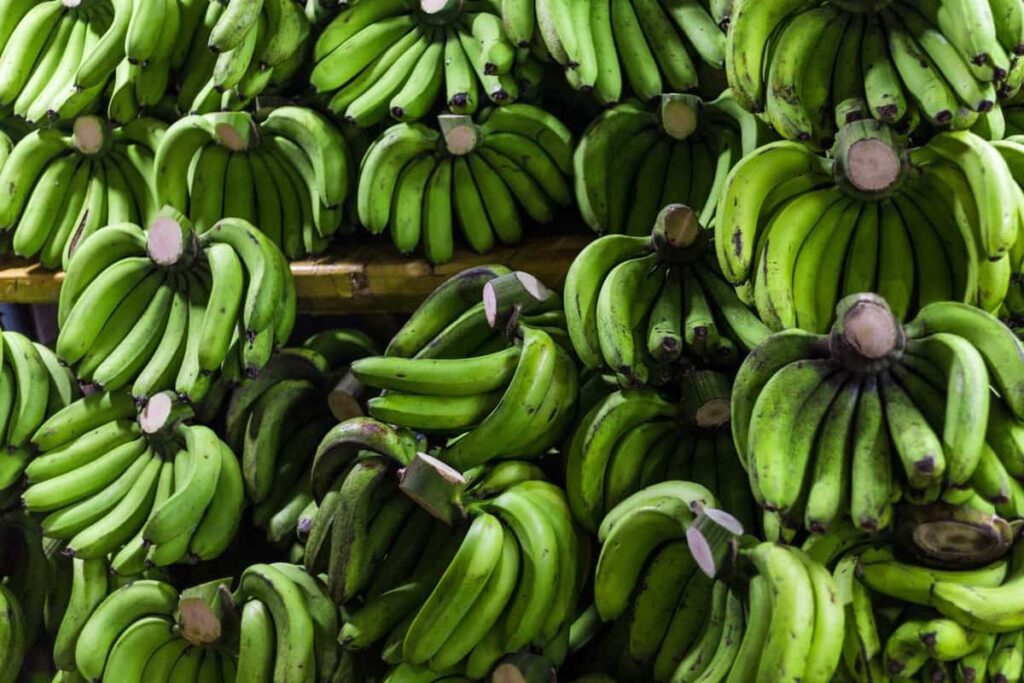
| State | Harvesting season of Banana |
| Maharashtra | Kharif: June – July Rabi: October – November |
| Kerala | Rainfed: April – May Irrigated crop: August – September |
| Tamil Nadu | February – April November – December |
Conclusion
There is a significant variation in yield per acre between varieties and seasons. Therefore, choosing the suitable Banana variety discussed above and sowing and harvesting times will make it easier for you to cultivate Bananas and get high yields.
- Aquaponic Farming at Home: A Step-By-Step Guide
- Profitable Village Farming Business Ideas in 2024
- High-Yield Aquaculture: Fast-Growing Fish for Farming
- Effective Fish Pond Construction Techniques for Beginners
- Irrigation and Water Management in Pineapple Farming
- Blossom to Harvest: Mastering Flowering and Pollination in Papaya Farming
- Pig Fattening Essentials: From Selection to Sale for Beginners
- Raising Wagyu Cattle: A Complete Guide for Premium Beef Production
- Soil Types and Their Water Holding Capacity
- Optimizing Irrigation Schedules for Coconut Groves for Enhanced Yield
- Espresso Your Garden: Coffee Grounds for Healthier Acid-Loving Plants
- The Best Soil Mix for Snake Plants: How to Mix Your Own Snake Plant Soil
- Green Thumb Success: Expert Tips for Cultivating Greenhouse Beans All Year Round
- Bloom All Year Round: The Ultimate Guide to Indoor Hyacinth Care
- Eco-Friendly Gardening: How to Make Liquid Fertilizer from Kitchen Waste
- Ultimate Guide to Grow Anise in Pots: Explore Seed Propagation to Harvesting
- Guide to Raising Chester White Pigs: Discover Breed Facts to Growth Management
- Mastering the Elegance: The Ultimate Guide to Weeping Cherry Tree Care, Planting, and Maintenance
- Ultimate Guide to Planting Garlic in Grow Bags: Growing Strategies for Beginners
- How to Fix Spider Plant Leaf-Related Problems: Natural and Organic Remedies
- 10 Reasons Why Your Tulsi Plant is Shedding Leaves: Home Remedies and Solutions
- Optimizing Growth and Yield: The Advantages of Palm Bunch Ash Fertilizer
- Utilizing Neem Oil Extract as a Natural Pesticide for Hydrangea
- From Soil to Harvest: Various Ways in Which Farmers Can Use AI Tools
- Steps to Encourage and Induce Citrus Flowers: A Comprehensive Guide
- How to Fix Snake Plant Leaf-Related Issues: Natural and Organic Remedies
- Transform Your Garden into a Fragrant Oasis with Raat Ki Rani (Night Blooming Jasmine)
- Discover the Ideal Chicken Breeds for Philippine Farms
- How to Create a Poultry Egg Farm Business Plan for Profits
- Grow Lemon Cucumbers Like a Pro: Insider Techniques for Bountiful Yields
- Ultimate Guide to Caring for Your Pink Princess Philodendron: Tips for Thriving Variegation
- Areca Nut Profit Per Acre: Calculating Yield and Cost of Cultivation
- How Kaveri Chicken is Becoming a More Profitable Breed in Indian Backyards
- Transform Your Barn: 9 Steps to Convert a Horse Stall into a Chicken Coop
- Exploring Suffolk Sheep Disadvantages with Limitations and Challenges
- Guide to Solving Potted Lemon Tree Problems: How to Revive Lemon Tree in Containers
